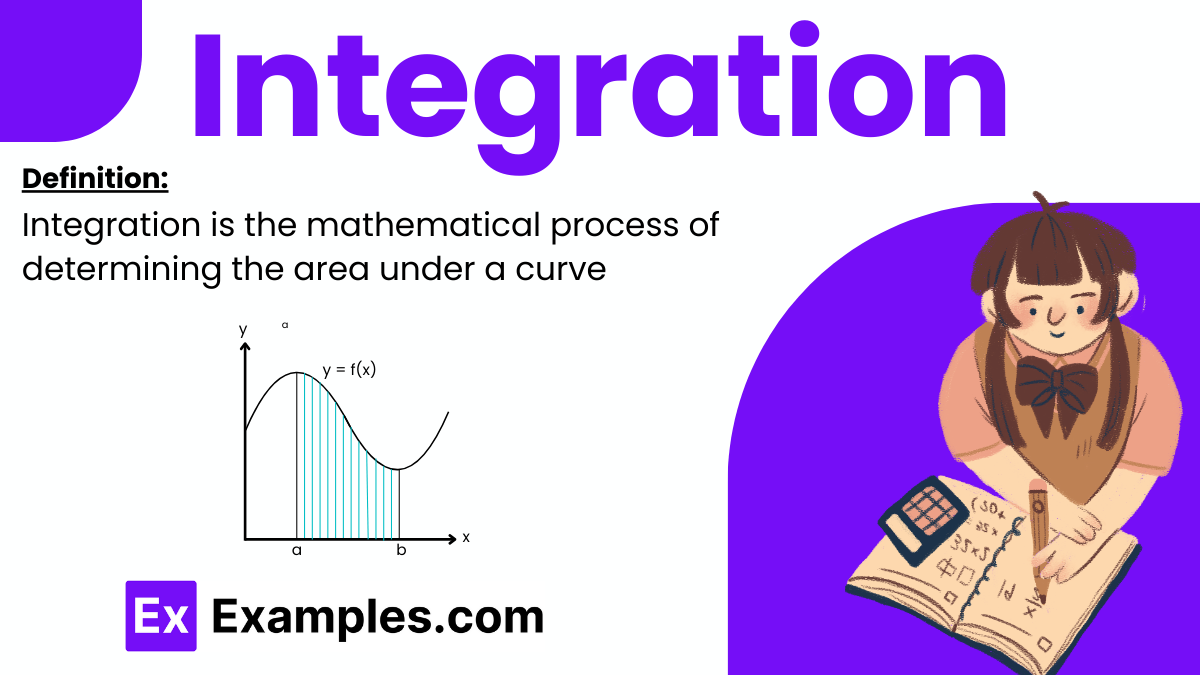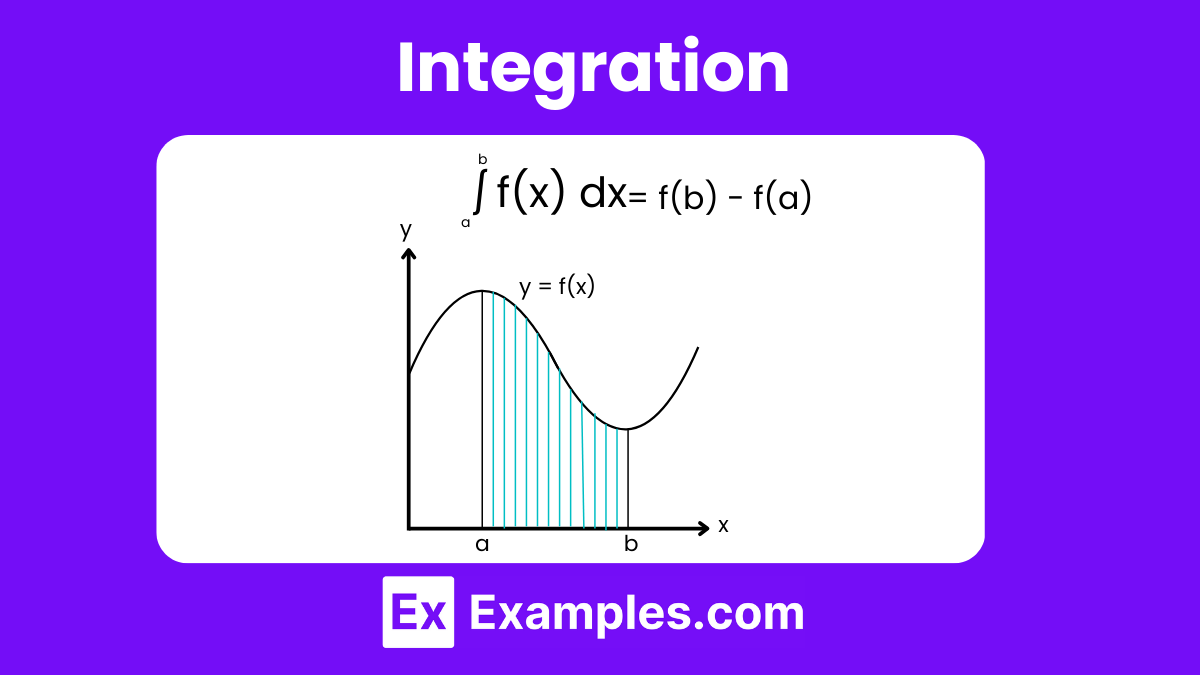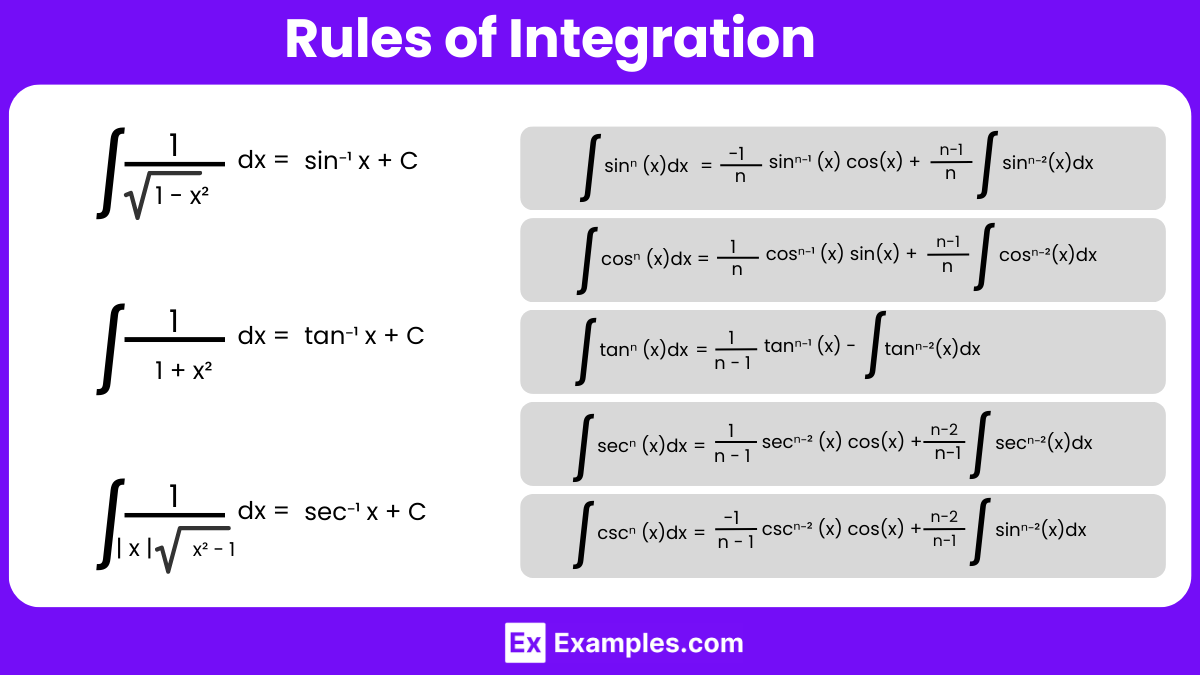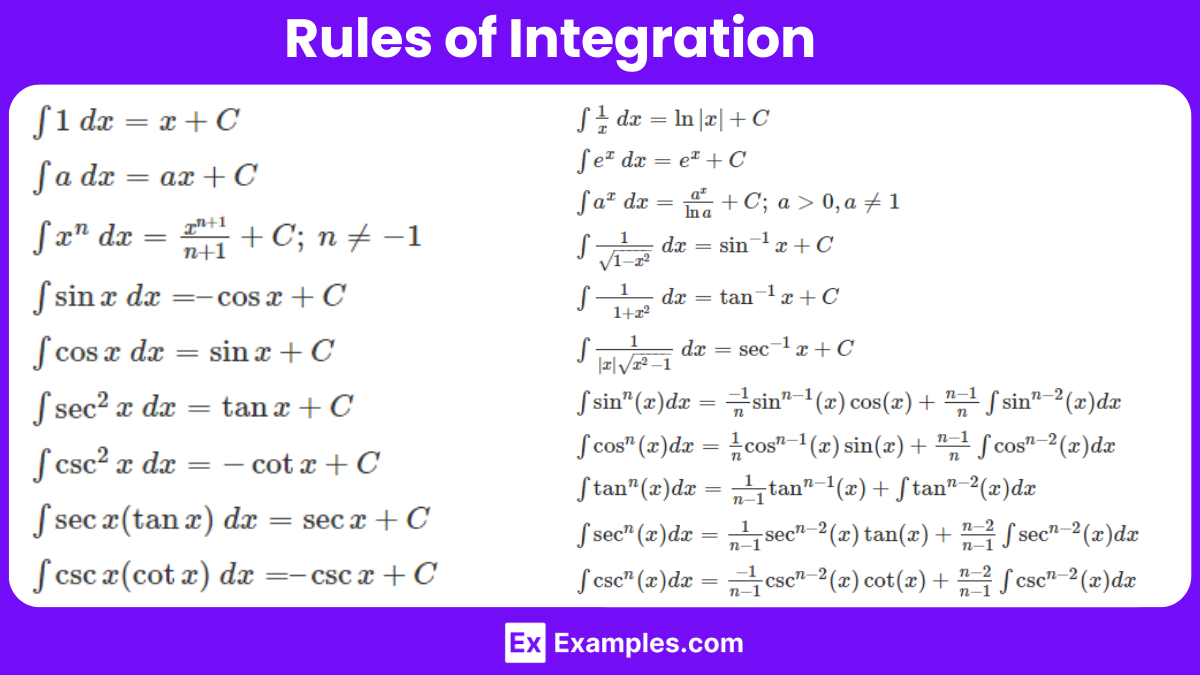What is the integral of \(\int x \, dx\)?
\(\frac{x^2}{2}\)
\(x^2\)
\(2x\)
\(\frac{x^3}{3}\)


Integration is a fundamental concept in mathematics, particularly within the field of calculus. It represents the process of calculating the area under a curve described by a mathematical function, enabling a deeper understanding of the space and the changes within that space. Integration allows us to sum up parts to find the whole, which is particularly useful in various scientific and engineering applications.
Integration is the mathematical process of determining the area under a curve. This involves approximating the area by summing the areas of numerous small rectangles beneath the curve, with the total becoming increasingly accurate as more rectangles are used. This sum approaches a precise value, known as the integral of the function, which represents the area under the curve within specified limits. Integration is also described as finding the antiderivative of a function, meaning it determines a function whose derivative is the original function. When a function is integrable and its integral over a specified domain is finite, this results in what is known as definite integration.
If d/dx(F(x) = f(x), then ∫ f(x) dx = F(x) +C. These are indefinite integrals. For example, let f(x) = x⁴ be a function. The derivative of f(x) is f’(x) = 3x² and the antiderivative of 3x² is f(x) = x³

| Function F(x) | Derivative F'(x) = f(x) | Antiderivative of f(x) |
| x³ + 0 | 3x² | x³ + ? |
| x³ + 2 | 3x² | x³ + ? |
| x³ – 4 | 3x² | x³ + ? |


We are familiar with the derivative formulas for key functions, which directly inform their corresponding standard integrals. Below are a few important integration formulas derived from these well-known derivative relationships.
Sum and Difference Rules:
Power Rule: ∫ xⁿ dx = (xⁿ⁺¹)/ (n+1)+ C. (Where n ≠ -1)
Exponential Rules:
Constant Multiplication Rule:
Reciprocal Rule:
A few properties of indefinite integrals are:
Integration is a fundamental concept in calculus used to compute areas under curves, volumes, and other quantities that aggregate infinitesimal data points. Here are some key methods of integration used in mathematics:
This method involves changing the variable of integration to simplify the integral. It’s particularly useful when dealing with composite functions or integrals involving trigonometric identities. The substitution is usually chosen to make the integral look simpler or more standard.
Based on the product rule for differentiation, integration by parts is used when integrating the product of two functions. It is often applied when one function is easily integrable and the other is easily differentiable.
When integrating rational functions, where the numerator and denominator are polynomials, the partial fractions method is useful. This approach involves decomposing a complex fraction into simpler fractions that are easier to integrate.
This involves integrating functions that contain trigonometric expressions. Techniques like using trigonometric identities to simplify the integrals or converting products of sine and cosine into sums or differences are common.
Used for integrals containing square roots of expressions like 𝑎²−𝑥², 𝑎²+𝑥², or 𝑥²−𝑎². Trigonometric substitution simplifies these types of integrals into standard trigonometric integrals by substituting a trigonometric function for 𝑥.
These are used when the limits of the integral are infinite or the integrand has an infinite discontinuity within the limits of integration. Such integrals are handled by defining them as limits of proper integrals as the interval grows infinitely large or approaches the point of discontinuity.
When an integral cannot be solved analytically, numerical methods such as the Trapezoidal Rule, Simpson’s Rule, or Monte Carlo integration are used to approximate the value of the integral.
Integral calculus is a branch of calculus that deals with the concept of integration, an essential mathematical operation used to determine the accumulation of quantities and the areas under and between curves. Here’s a detailed look at integral calculus:
Integration is the inverse process of differentiation. While differentiation focuses on rates of change and slopes of curves, integration deals with the accumulation of quantities, such as areas under curves, volumes of solids, and other related sums over intervals.
This theorem bridges the concepts of differentiation and integration, stating that:
Several techniques are employed to perform integrations, particularly when functions are complex:
Integration is fundamentally the inverse process of differentiation in calculus. While differentiation focuses on finding the rate at which one quantity changes with respect to another, integration involves accumulating the quantities to determine the total effect of these changes over a period or along a continuum.
Differentiation and integration are two core operations in calculus, often referred to as the fundamental theorems of calculus. Here’s how they connect:
Integration serves a variety of purposes across different fields:
To effectively apply integration:
Beyond mathematics, integration refers to the act of bringing together diverse components or groups to function as a unified system.
The basic concept of integration involves merging separate elements so they operate as one cohesive unit. It focuses on creating harmony and unity among differing parts.
“Integration into” describes the process of becoming part of a larger whole. It often involves assimilating into a new environment or system smoothly and effectively.
In real life, integration means combining different aspects of society, such as cultural, racial, or economic elements, to create a more cohesive and inclusive community.
In people, integration refers to the process of individuals from diverse backgrounds merging into a single, unified community, emphasizing inclusivity and equal participation.
“Unification” is another word for integration, highlighting the process of bringing together separate parts to form a complete, unified entity.
Synonyms for integration include amalgamation, unification, merger, blending, and consolidation, each emphasizing aspects of combining elements into a whole.
Two synonyms for integrate are “merge” and “combine,” both implying the action of joining or mixing elements together to form a cohesive unit.
The purpose of integration is to achieve unity and coherence by bringing together diverse elements, enhancing functionality, and fostering inclusivity in various contexts.
Text prompt
Add Tone
10 Examples of Public speaking
20 Examples of Gas lighting
What is the integral of \(\int x \, dx\)?
\(\frac{x^2}{2}\)
\(x^2\)
\(2x\)
\(\frac{x^3}{3}\)
Evaluate \(\int (3x^2 - 4x + 1) \, dx\).
\(x^3 - 2x^2 + x\)
\(x^3 - 2x^2 + x + C\)
\(x^3 - 2x^2 + 2x + C\)
\(3x^3 - 4x^2 + x + C\)
What is the integral of \(\int e^x \, dx\)?
\(e^x + C\) \
\(e^{x+1}\)
\(x e^x\)
\(\frac{e^x}{x}\)
Find \(\int (2x + 3) \, dx\).
\(x^2 + 3x + C\)
\(x^2 + 3x\)
\(2x^2 + 3x + C\)
\(2x^2 + 3x\)
Evaluate \(\int x^3 \, dx\).
\(\frac{x^4}{4} + C\)
\(\frac{x^3}{3} + C\)
\(\frac{x^5}{5} + C\)
\(\frac{x^2}{2} + C\)
What is \(\int (\sin x) \, dx\)?
\(-\cos x + C\)
\(\cos x + C\)
\(\sin x + C\)
\(-\sin x + C\)
Find \(\int \frac{1}{x} \, dx\).
\(\ln |x| + C\)
\(\ln |2x| + C\)
\(\frac{1}{x} + C\)
\(x + C\)
Evaluate \(\int (4x - 5) \, dx\).
\(4x^2 - 5x + C\)
\(2x^2 - 5x + C\)
\(4x^2 - 5x\)
\(2x^2 - 5x\)
What is \(\int (3x^2 + 2x - 1) \, dx\)?
\(x^3 + x^2 - x + C\)
\(x^3 + x^2 - x\)
\(3x^3 + x^2 - x + C\)
\(x^3 + 2x^2 - x + C\)
Find the integral of \(\int \cos x \, dx\).
\(-\sin x + C\)
\(\cos x + C\)
\(-\cos x + C\)
\(\sin x + C\)
Before you leave, take our quick quiz to enhance your learning!

